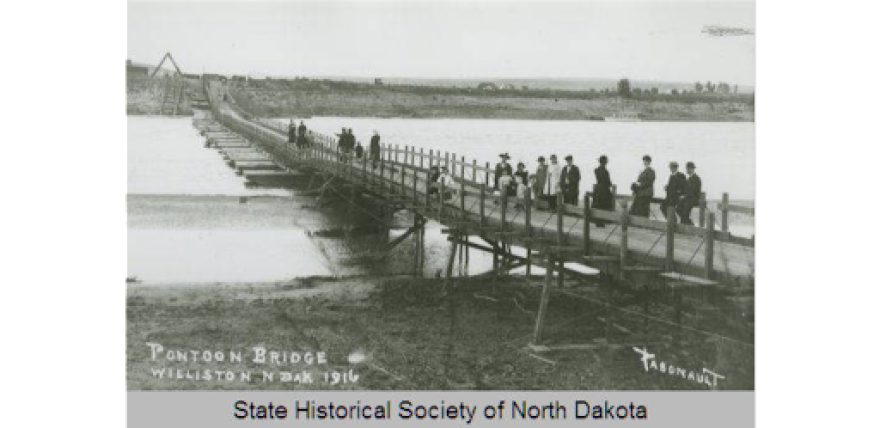On this date in 1916, residents of Williams and McKenzie Counties learned that they would soon be able to cross the Missouri River at Williston with no difficulty. The Golden Valley Chronicle announced that a new pontoon bridge would be ready before the end of the month. Mr. P.M. Calderwood, president of the Missouri River Bridge Company of Williston, announced that only unforeseen delays could prevent the bridge from opening on time.
A pontoon bridge uses floats to support a deck for vehicles and pedestrians. Most pontoon bridges are temporary, often used during wartime or in cases of civil emergency. But pontoon bridges for civilian use are sometimes designed to be permanent. This was the case with the bridge at Williston.
Pontoon bridges can be less expensive to build, but some have suffered catastrophic failures. The bridge can fall apart if the anchors holding the floats fail. This is most often due to flooding or high winds. Mr. Calderwood assured the public that the company was using new technology. Federal engineers had inspected the work and declared it safe.
Work on the bridge was moving ahead at a furious pace. Seven of the twenty-two pontoons were already completed. Each float was twenty-six feet long, eight feet wide, and four feet deep. The upstream ends sloped upwards to allow ice, driftwood, and other debris to pass safely under instead of getting stuck. Each float was fitted with a watertight cover and they were all connected by iron rods. As a safety measure, they were also attached to an overhead cable. The system did not rely on anchors in the riverbed. This allowed the bridge to rise and fall with the level of the river.
Residents eagerly anticipated the opening of the bridge. It was expected that large numbers of McKenzie County residents would use the bridge to attend the Williams County Fair that would get underway on August first.
The bridge did, indeed, make life easier for local residents, but not for long. Less than two years later, it was destroyed in the flooding of 1918.
Dakota Datebook written by Carole Butcher
Sources:
Golden Valley Chronicle. “Big Pontoon Bridge Ready in a Few Weeks.” Beach ND. 8/11/1916. Page 7.
Digital Public Library of America. “Pontoon Bridge at Williston.” https://bscdn.dp.la/item/3d80701d59c6319978b9eef5bd64c437?provider=%22State%20Historical%20Society%20of%20North%20Dakota%22&page=1&subject=%22Water%22&location=%22Williston%20(N.D.)%3B%20Missouri%20River%3B%22 Accessed 7/11/2021.
Britannica. “Pontoon Bridge.” https://www.britannica.com/technology/pontoon-bridge Accessed 7/11/2021.



